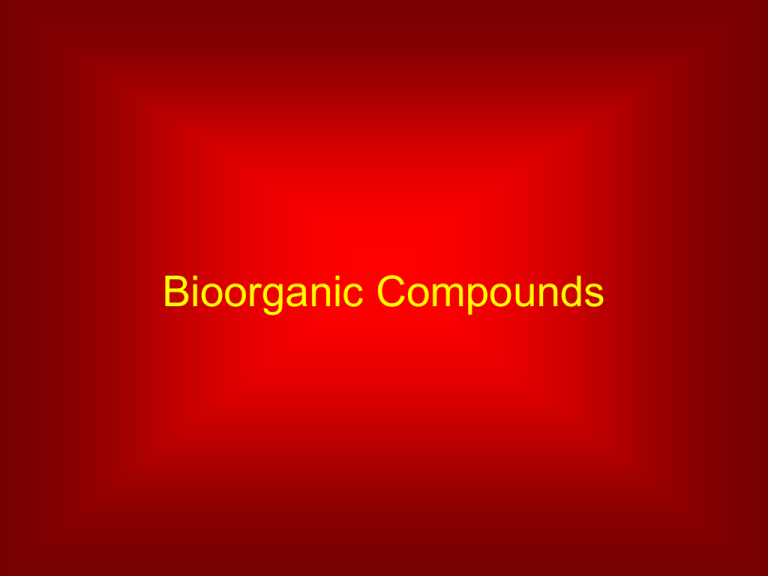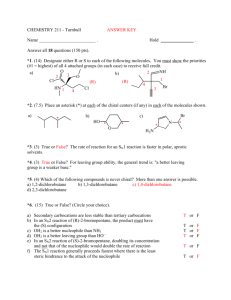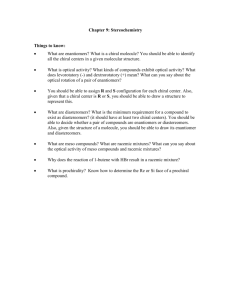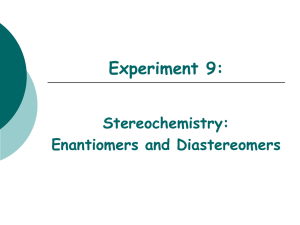Carey Chapter 7 Stereochemistry
advertisement

Bioorganic Compounds Bioorganic Compounds • • • • • Amino Acids – Proteins Lipids Carbohydrates Nucleic Acids Miscellaneous • Alkaloids • Vitamins • Drugs In most cases biological activity depends on stereochemistry Stereochemistry Stereochemistry • Deals with: • Determination of the relative positions in space of atoms, groups of atoms • Effects of positions of atoms on the properties • Sterical structure: • Constitution • Configuration • Conformation Isomers constitutional isomers stereoisomers Isomers constitutional isomers enantiomers stereoisomers diastereomers Chirality A molecule is chiral if its two mirror image forms are not superposable upon one another. ASYMMETRIC! A molecule is achiral if its two mirror image forms are superposable. SYMMETRIC! Bromochlorofluoromethane is chiral Cl Br H F It cannot be superposed point for point on its mirror image. Bromochlorofluoromethane is chiral Cl Cl Br Br H F H F To show nonsuperposability, rotate this model 180° around a vertical axis. Another look Chlorodifluoromethane is achiral The two structures are mirror images, but are not enantiomers, because they can be superposed on each other. The Chirality Center The Chirality Center a carbon atom with four different groups attached to it w x C z y also called: chiral center asymmetric center stereocenter stereogenic center Chirality and chirality centers A molecule with a single chirality center is chiral. Bromochlorofluoromethane is an example. H Cl C Br F Chirality Centers Other Than Carbon Silicon b b a a Si c d d Si c Silicon, like carbon, forms four bonds in its stable compounds and many chiral silicon compounds have been resolved Nitrogen in amines b b a a very fast N c : : N c Pyramidal geometry at nitrogen can produce a chiral structure, but enantiomers equilibrate too rapidly to be resolved Sulfur in sulfoxides b b a a slow +S O_ : : S+ O_ Pyramidal geometry at sulfur can produce a chiral structure; pyramidal inversion is slow and compounds of the type shown have been resolved A molecule with a single chirality center must be chiral. But, a molecule with two or more chirality centers may be chiral or it may not. Chiral Allenes Allenes of the type shown are chiral X A C C C Y B A B; X Y Have a stereogenic axis Stereogenic Axis analogous to difference between: a screw with a right-hand thread and one with a left-hand thread a right-handed helix and a left-handed helix Absolute and Relative Configuration Configuration Relative configuration compares the arrangement of atoms in space of one compound with those of another. Until the 1950s, all configurations were relative Absolute configuration is the precise arrangement of atoms in space. We can now determine the absolute configuration of almost any compound Fisher Projections Purpose of Fischer projections is to show configuration at chirality center without necessity of drawing wedges and dashes or using models. Rules for Fischer projections H Cl Br F Arrange the molecule so that horizontal bonds at chirality center point toward you and vertical bonds point away from you. Rules for Fischer projections H Cl Br F Projection of molecule on page is a cross. When represented this way it is understood that horizontal bonds project outward, vertical bonds are back. O C H O C H OH C HO Absolute configuration: H H C 1.) D/L system 2.) R/S system CH2OH CH2OH D(+)-glyceraldehyde C H (ox) C C L (-)-glyceraldehyde C X (red) D-configuration X (ox) C C D = dexter = right = R = rectus H (red) L-configuration L = levus = left = S = sinister Configuration of Amino Acids The Cahn-Ingold-Prelog R-S Notational System The Cahn-Ingold-Prelog Rules 1. Rank the substituents at the stereogenic center according to decreasing atomic number. 2. Orient the molecule so that lowest-ranked substituent points away from you. CIP Rules (2) When two atoms are identical, compare the atoms attached to them on the basis of their atomic numbers. Precedence is established at the first point of difference. —CH2CH3 outranks —CH3 —C(C,H,H) —C(H,H,H) CIP Rules (3) Work outward from the point of attachment, comparing all the atoms attached to a particular atom before proceeding further along the chain. —CH(CH3)2 outranks —CH2CH2OH —C(C,C,H) —C(C,H,H) CIP Rules (4) Evaluate substituents one by one. Don't add atomic numbers within groups. —CH2OH outranks —C(CH3)3 —C(O,H,H) —C(C,C,C) CIP Rules (5) An atom that is multiply bonded to another atom is considered to be replicated as a substituent on that atom. —CH=O outranks —CH2OH —C(O,O,H) —C(O,H,H) (A table of commonly encountered substituents ranked according to precedence is given on the inside back cover of the text.) Example 1 1 17 1 35 4 2 9 2 Order of decreasing rank 4 of 3 2 9 anticlockwise S clockwise R H=1 35 1 3 3 4 17 F=9 Cl=17 Br=35 Application of C. I. P. rules for Geometric Isomers CH3 CH3 C C H E/Z system H C 2 1 Br Br 1 CH3 C CH3 trans 1 Cl C H cis 2 H CH3 C CH2 CH3 (Z)-1-Bromo-1-chloro-2-methyl-1-butene Zusammen = together 2 C Cl 2 CH3 C 1 CH2 CH3 (E)-1-Bromo-1-chloro-2-methyl-1-butene Entgegen = opposit CIP Rules (1) Higher atomic number outranks lower atomic number Br > F Cl > H higher Br C lower F Cl higher H lower C (Z )-1-Bromo-2-chloro-1-fluoroethene The E-Z Notational System E : higher ranked substituents on opposite sides Z : higher ranked substituents on same side higher C lower lower C higher Entgegen higher C lower higher C lower Zusammen Physical properties of enantiomers Same: melting point, boiling point, density, etc Different: properties that depend on shape of molecule (biological-physiological properties) can be different Properties of Chiral Molecules: Optical Activity Optical Activity A substance is optically active if it rotates the plane of polarized light. In order for a substance to exhibit optical activity, it must be chiral and one enantiomer must be present in excess of the other. Light has wave properties periodic increase and decrease in amplitude of wave Light optical activity is usually measured using light having a wavelength of 589 nm this is the wavelength of the yellow light from a sodium lamp and is called the D line of sodium Polarized light ordinary (nonpolarized) light consists of many beams vibrating in different planes plane-polarized light consists of only those beams that vibrate in the same plane Polarization of light Nicol prism Rotation of plane-polarized light Specific rotation observed rotation () depends on the number of molecules encountered and is proportional to: path length (l), and concentration (c) therefore, define specific rotation [] as: [] = 100 cl concentration = g/100 mL length in decimeters Racemic mixture a mixture containing equal quantities of enantiomers is called a racemic mixture a racemic mixture is optically inactive ( = 0) a sample that is optically inactive can be either an achiral substance or a racemic mixture Optical purity an optically pure substance consists exclusively of a single enantiomer enantiomeric excess = % one enantiomer – % other enantiomer % optical purity = enantiomeric excess e.g. 75% (-) – 25% (+) = 50% opt. pure (-) Resolution of Enantiomers Separation of a racemic mixture into its two enantiomeric forms Resolution of a racemic modification 1. Physical methods: - Spontaneous resolution - Inclusion compounds - Chromatography 2. Chemical methods: - Diastereomeric salt formation 3. Biochemical methods: - Enzymatic decomposition Strategy enantiomers C(+) C(-) Strategy enantiomers C(+) C(-) 2P(+) C(+)P(+) C(-)P(+) diastereomers Strategy enantiomers C(+) C(-) 2P(+) C(+)P(+) C(-)P(+) C(+)P(+) C(-)P(+) diastereomers Strategy enantiomers C(+) C(+) P(+) C(-) 2P(+) C(+)P(+) C(-)P(+) C(+)P(+) C(-)P(+) diastereomers P(+) C(-) Resolution of a Racemic Mixture (S)-base (R)-acid (S)-acid enantiomers (R,S)-salt (S,S)-salt diastereomers (R,S)-salt (S,S)-salt HCl HCl (S)-baseH+ (S)-baseH+ + + (S)-acid (R)-acid Lock and Key Model CHO CH2OH H H C OH H CHO OH H CHO C OH CH2OH CHO OH Discrimination of Enantiomers by Biological Molecules Chiral Molecules with Two Chirality Centers How many stereoisomers when a particular molecule contains two chiral centers? 2,3-Dihydroxybutanoic acid O 3 2 CH3CHCHCOH HO OH 4 Combinations = 4 Stereoisomers Carbon-2 R Carbon-3 R R S S R S S CO2H [] = -9.5° CO2H [] = +9.5° R S HO H OH H OH H enantiomers HO R H S CH3 CH3 diastereomers CO2H CO2H S R HO HO H OH H H enantiomers OH H R S CH3 [] = +17.8° [] = -17.8° CH3 Three stereoisomers of 2,3-butanediol CH3 CH3 H HO OH H H HO CH3 OH H OH H H OH CH3 CH3 CH3 2R,3R 2S,3S 2R,3S chiral chiral achiral How many stereoisomers? maximum number of stereoisomers = 2n where n = number of structural units capable of stereochemical variation structural units include chirality centers and cis and/or trans double bonds number is reduced to less than 2n if meso forms are possible Cholic acid HO H CH3 H H CH2CH2COOH H H3C HO CH3 H OH 11 chirality centers 211 = 2048 stereoisomers one is "natural" cholic acid a second is the enantiomer of natural cholic acid 2046 are diastereomers of cholic acid




